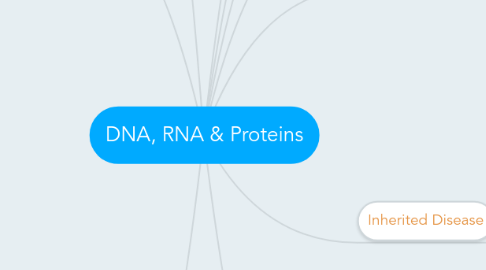
1. The Bases
1.1. There are only 4 bases in the DNA but they are very inportant
1.2. The order of just these 4 bases code for every part and kind of life
1.3. The 4 Bases
1.3.1. Adenine
1.3.2. Cytosine
1.3.3. Guanine
1.3.4. Thymine
1.4. The Bases rule
1.4.1. A always pairs with T
1.4.2. C always pairs with G
1.5. The bases are held together by weak hydrogen bonds
2. Amino Acids
2.1. There are 20 different amino acids
2.1.1. Different Amino Acids make different types of proteins
2.2. Each triplet codes for a single Amino Acid
2.3. The order of Amino Acids is determined by the order of the bases on the DNA in the gene
2.4. Once we have a chain of Amino Acids it is folded to give the protein its final shape
2.5. The type of protein molecule produced depends on the precise arrangement of the Amino Acids
3. Proteins
3.1. Proteins are large molecules made up of chains of smaller amino acid molecules
3.2. Examples of what Proteins are needed for
3.2.1. Growth (including making new cells - mitosis)
3.2.2. Repair of damaged tissue
3.2.3. Enzymes
3.2.4. Antibodies
3.2.5. Hormones
3.2.6. Building structures
3.2.6.1. Muscle
3.2.6.2. Bone
3.2.6.3. Skin
3.2.6.4. Hair
3.3. How Proteins are made
3.3.1. At the ribosomes, amino acids are joined together into single chains of amino acids called polypeptides
3.4. Types of Proteins
3.4.1. Globular Proteins
3.4.1.1. The polypeptide chains are folded together into a round shape
3.4.1.2. Examples
3.4.1.2.1. Hormones
3.4.1.2.2. Enzymes
3.4.1.2.3. Antibodies
3.4.2. Conjugated Proteins
3.4.2.1. These contain a globular protein and non-protein part
3.4.2.2. For example, Haemoglobin (the red pigment in red blood cells) is a conjugated protein
4. Chromosomes are the thread like structures in the nucleus of the cell that carry genetic information
5. A gene is a section of a chromosome which contains a separate piece of genetic information (coded instructions for making a protein)
6. DNA stands for Deoxyribo Nucleic Acid
7. Chromosomes and their genes are made of DNA
8. The Structure of DNA
8.1. DNA has a very distinctive 'double helix' shape made of two strands of bases twisted together. This structure is often likened to a 'twisted ladder'
9. Inherited Disease
9.1. Sometimes there are errors in the genetic code called mutations
9.1.1. If the code is wrong, the protein is either not made or is faulty
9.2. Example of an Inherited Disease
9.2.1. Sickle Cell Anaemia
9.2.1.1. With Sickle Cell Anaemia, the error in the genetic code also results in a faulty protein being amino acids
9.2.1.1.1. This results in sickle shaped blood cells which cannot transport oxygen around the body effectively
9.3. Identifying the Disease
9.3.1. A karyotype is a picture in which the chromosomes of a cell have been stained so that the banding pattern of the chromosomes are visible
9.3.2. Karyotypes have become increasingly important to genetic counsellors as disorders and diseases have been traced to specific visible abnormalities of the chromosome
10. Messenger RNA
10.1. Messenger RNA is single stranded
10.2. Has Uricil base instead of Thymine
10.3. How it works
10.3.1. Messenger RNA (mRNA) is made in the nucleus and carries a copy of the DNA base sequence of a specific gene to the ribosomes in the cytoplasm
10.3.2. Ribosomes attach to the mRNA and the instructions it carries are used to assemble amino acids in the correct order to make a specific protein
